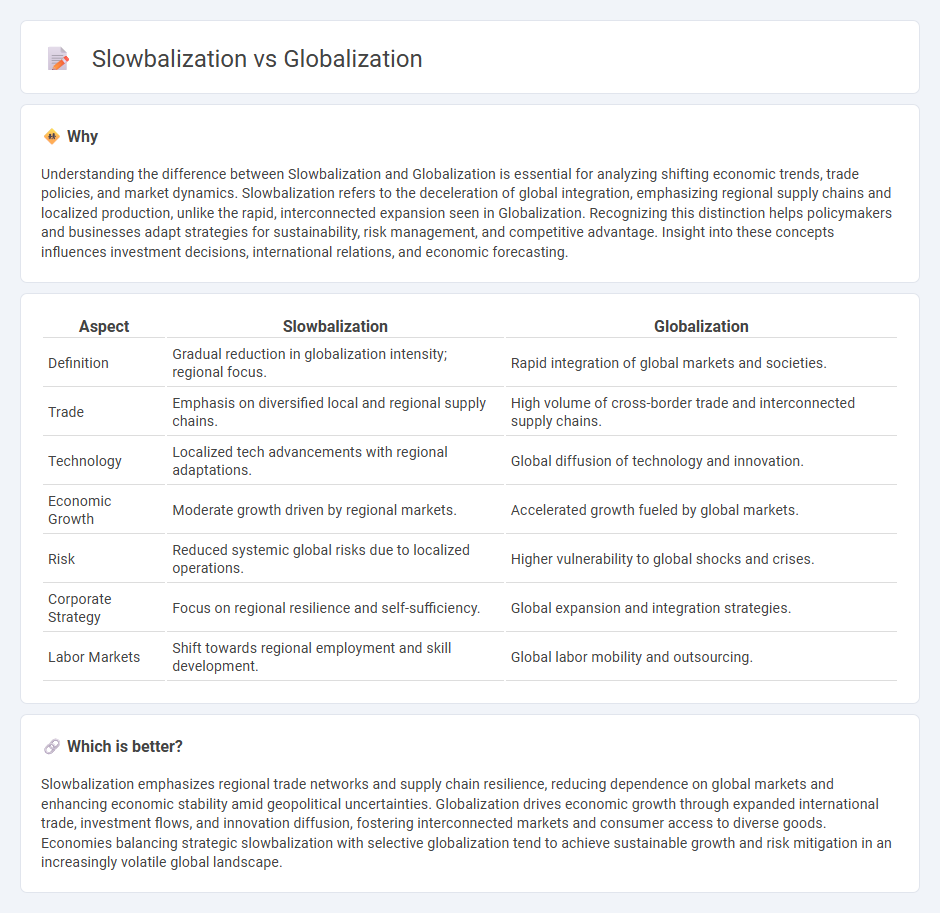
Slowbalization marks a shift from rapid globalization toward more localized economic networks and regional trade agreements, impacting global supply chains and investment flows. This trend reflects increasing geopolitical tensions, rising protectionism, and a focus on sustainability and resilience in economic policies. Explore how slowbalization reshapes market dynamics and future economic prospects.
Why it is important
Understanding the difference between Slowbalization and Globalization is essential for analyzing shifting economic trends, trade policies, and market dynamics. Slowbalization refers to the deceleration of global integration, emphasizing regional supply chains and localized production, unlike the rapid, interconnected expansion seen in Globalization. Recognizing this distinction helps policymakers and businesses adapt strategies for sustainability, risk management, and competitive advantage. Insight into these concepts influences investment decisions, international relations, and economic forecasting.
Comparison Table
| Aspect | Slowbalization | Globalization |
|---|---|---|
| Definition | Gradual reduction in globalization intensity; regional focus. | Rapid integration of global markets and societies. |
| Trade | Emphasis on diversified local and regional supply chains. | High volume of cross-border trade and interconnected supply chains. |
| Technology | Localized tech advancements with regional adaptations. | Global diffusion of technology and innovation. |
| Economic Growth | Moderate growth driven by regional markets. | Accelerated growth fueled by global markets. |
| Risk | Reduced systemic global risks due to localized operations. | Higher vulnerability to global shocks and crises. |
| Corporate Strategy | Focus on regional resilience and self-sufficiency. | Global expansion and integration strategies. |
| Labor Markets | Shift towards regional employment and skill development. | Global labor mobility and outsourcing. |
Which is better?
Slowbalization emphasizes regional trade networks and supply chain resilience, reducing dependence on global markets and enhancing economic stability amid geopolitical uncertainties. Globalization drives economic growth through expanded international trade, investment flows, and innovation diffusion, fostering interconnected markets and consumer access to diverse goods. Economies balancing strategic slowbalization with selective globalization tend to achieve sustainable growth and risk mitigation in an increasingly volatile global landscape.
Connection
Slowbalization represents a shift within the broader trend of globalization, marked by a deceleration in the pace of global economic integration and cross-border trade. This phenomenon reflects rising geopolitical tensions, protectionist policies, and supply chain restructurings that affect international investment and market connectivity. Understanding the interplay between slowbalization and globalization is crucial for predicting future economic growth patterns and international cooperation.
Key Terms
Trade Integration
Trade integration under globalization emphasizes rapid expansion of cross-border commerce driven by reduced tariffs and technological advancements, fostering interconnected supply chains and market access. Slowbalization reflects a tempered approach, marked by cautious trade policies, regionalization, and supply chain diversification to mitigate risks and geopolitical tensions. Explore how evolving trade integration strategies reshape the global economic landscape in detail.
Supply Chains
Globalization has driven the integration of international supply chains, boosting efficiency through widespread sourcing and distribution networks. Slowbalization, by contrast, emphasizes regionalization and resilience, reducing reliance on distant suppliers to mitigate risks such as geopolitical tensions and pandemics. Explore how businesses adapt their supply chain strategies to balance cost and risk in an evolving global landscape.
Protectionism
Protectionism has resurged amid the shift from globalization to slowbalization, marked by increased tariffs, trade barriers, and policies aimed at safeguarding domestic industries. Countries prioritize economic sovereignty and local job preservation, leading to a more cautious approach to international trade and investment. Explore how these protectionist trends impact global markets and supply chains by diving deeper into this evolving economic landscape.
Source and External Links
What is Globalization? Examples, Definition, Benefits and Effects - Globalization refers to the increasing movement and exchange of people, goods, services, capital, technologies, and cultural practices worldwide, accelerating economic growth and cultural exchanges since the 1970s through free trade policies.
Globalization - Wikipedia - Globalization is the integration and interdependence of economies, markets, societies, and cultures via trade, investment, migration, and knowledge dissemination, which intensified between 1990 and 2010 due to technology and trade liberalization.
6 Pros and Cons of Globalization in Business to Consider - The advantages of globalization include expanded economic growth through access to labor, jobs, resources, and national specialization in production, enabling countries to leverage their strengths and trade for other goods.
 dowidth.com
dowidth.com